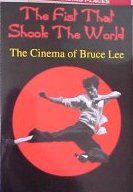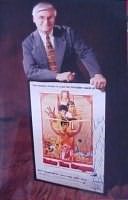| An Interview with author Lou Gaul - "The Fist that shook the World" | ||||
|
|
 The
Bruce Lee Club has recently interviewed Lou Gaul, the author
of "The Fist that shook the World,". The
Bruce Lee Club has recently interviewed Lou Gaul, the author
of "The Fist that shook the World,".
Lou has kindly agreed to answer questions put from the fans of Bruce Lee in the UK.
Background Information When did you start your writing career? Like many college newspapers in the 1970s, the mood was very casual at the Signal and to my surprise and delight, my first review (of Mike Nichols' "Carnal Knowledge") appeared in print. I kept turning them in and the paper continued to print them, which sparked my interest in newspapers. After graduating in 1973, I landed a job at New Jersey's Burlington County Times (part of the Calkins Newspaper chain, which has six newspapers) as a news reporter. I took the job because the editor agreed to let me do film reviews and stories on my own time. The paper printed them, and with filmmakers like Sam Peckinpah, Martin Scorsese, Robert Altman and Francis Ford Coppola creating motion pictures, it was an amazing time for films. In 1976, I became the full-time film critic for the chain, a position I still hold and feel blessed to have. Thanks for the information Lou. Why did you decide to write a book about Bruce? When I first saw them, I wasn't working at the newspaper and promised myself that some day I would study the reaction and analyze Mr. Lee's impact on motion pictures. How long did it take for you to research your book on Bruce? At the university, a student had to team with a professor, who would agree to provide guidance and grades. I approached Professor William Everson, a wonderful teacher and author who has since passed away, and made my proposal. I thought he might have second thoughts, but instead, he was excited, because it was something so different. He had read many independent studies on talents such as Alfred Hitchcock, Howard Hawks, Orson Welles and others too numerous to mention. Reading about Bruce Lee intrigued him, and his support was the first step in my creating "The Fist That Shook the World."
I then put it on hold until the mid-1990s, when I approached Gary and Sue Svehla of Midnight Marquee Press in Baltimore, Maryland. They published mostly books on horror and fantasy but were intrigued by Bruce Lee. I then took a year (while working full-time for my newspaper) to expand all of the material, visually re-read the films and start intensive research into everything I could find published on Mr. Lee.
Who were the first and last persons you interviewed?
Did you interview Linda Lee?
|
In your book at the end of each film evaluation, you have a small
piece of information for people to watch out for in the movies. Whose
idea was that?
Do you intend to write a book about Brandon Lee?
The hardest part of writing "The Fist That Shook the World" was
doing research on the accidental shooting death of Brandon. I was
fortunate enough to meet him in New York City when he was doing
publicity for "Rapid Fire," and he had an incredible spark.
How many copies of "The Fist That Shook The World: The Cinema of
Bruce Lee" have you sold worldwide?
Do you intend to write any more books on Bruce Lee? I think my book is unique, because I approached Mr. Lee's work in a serious manner and visually analyzed his cinematic efforts. Throughout my life, I've been disappointed whenever people shrugged off Mr. Lee's films, tossing them aside like one of those poorly dubbed, haphazardly directed pictures that air on Saturday afternoons in America on shows called "Kung Fu Theater."His work is much deeper than that, which is something people can see and appreciate if they become active viewers willing to analyze the images and dialogue rather than passive viewers who simply want the combat scenes to wash over them. There are political overtones, social observations and much more, elements I'm sure Mr. Lee intended to insert. One fanzine-type publication, "Video Watchdog," which I respect, reviewed "The Fist That Shook The World" and took me to task for pointing out Mr. Lee's emotional outburst where he cries and actually jumps into the grave of his Master in "The Chinese Connection." (aka Fist of Fury UK). The reviewer felt that this type of crying scene had been done in countless martial arts pictures and was expected. The point I was trying to make was that Mr. Lee saw himself as a Steve McQueen-type figure, a superstar with an air of cool about him. Despite that, Mr. Lee was willing to bare his emotional soul (something most American stars never do out of fear that it reflects weakness) and do that scene. To me, it's of major importance, not only due to Mr. Lee's emotional performance but also because it reflected his real life in which he was late for his father's funeral and walked on his knees to the cassock in front of the coffin. Though respecting stars like McQueen, Lee was a performer who did things his way -- making him a true artist in the best sense of the word. Do you still have the "Enter the Dragon" poster which you were
photographed with for your book?
 I understand why people want such materials, but I never sought them out. Perhaps the images in the films were so vivid to me -- and are still so clear to me -- that I never felt the need to purchase posters or collectibles that would remind me of Mr. Lee and his work. Those images of Mr. Lee, I'm happy to say, remain as fresh to me as when I first saw them almost three decades ago. Thank you for your time Lou
it was a pleasure to talk to you.
Lou can be contacted by
email at LGaul@bti.calkinsnewspapers.com |
||